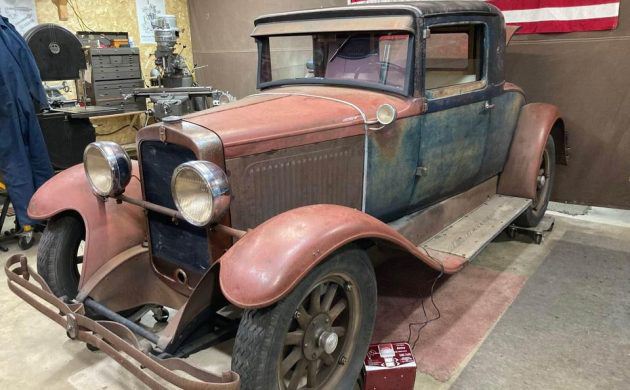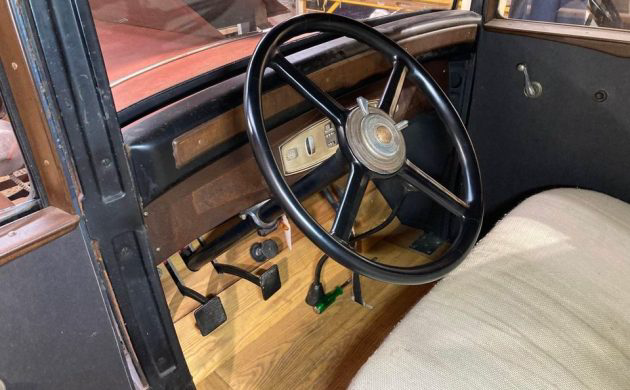Charles Nash founded Nash Motors in 1916 after purchasing the Kenosha, Wisconsin factory belonging to the bankrupt Thomas B. Jeffery Company, maker of a car called the Rambler (history rhymes, eh?). With WWI in full swing, a critical cash earner was the Jeffery Quad, a four-wheel drive platform capable of moving men, material, and equipment over harsh terrain. Nash Motors became the largest producer of four-wheel drive vehicles in the US by 1918. Once the war ended Nash focused on automobiles, and by the mid-1920s, automobile manufacturing was the top-ranked industry in Wisconsin. The company’s three assembly plants spawned hundreds of suppliers throughout the state. From Nash’s heyday here on facebook Marketplace is a 1929 Nash Standard Six project – already well underway – for $12,000. Take a trailer to Eaton Rapids, Michigan to retrieve her. We owe thanks to Ted for spotting this graceful pre-war coupe for us – thanks!
Charles Nash told his employees and dealers, “We shall build up to a standard; not down to a price.” Customers were receptive, and the company enjoyed a sales boom in 1928. The following year was shaping up nicely, too, with three models on offer in a variety of body styles. Our subject car is the base Standard Six, cradling a 183 cu. in. L-head six-cylinder engine in the bay. With a single Carter carburetor and a 5.0:1 compression ratio, this little guy makes about 50 hp. The seller notes that the engine has been rebuilt – and it looks every inch new. The Nash also has a new clutch for its three-speed manual gearbox and re-lined mechanical brakes. The frame has been blasted and repainted, and the wiring is new.
Inside, all the wood has been replaced, and the steering wheel appears to have been refinished. The seats are covered in muslin, awaiting an upholstery choice (leather or mohair, please). The Stewart Warner gauges should have ornamental brightwork frames and typically the inset was painted like this. The seller notes that new tires will be required. The bumper in the front needs to be rechromed; no photos of the rear were supplied but there’s likely a rumble seat back there. The windshield cranks out for ventilation, and one wiper is supplied for the driver’s side.
No doubt the seller has committed considerable hours and at least a few dollars toward bringing this Nash along the restoration path. But paint and bodywork are still on the docket – also requiring considerable dedication. Meanwhile, the value of orphan-make pre-war cars has diminished over the last several years. This Nash is the base model rather than the sexier Twin-Ignition OHV Advanced or Special Six, though at least it’s not a sedan. My guess is that the seller will need to discount his price to move this one along; what do you think?






I suppose I’m one of the few left that adds an emotional perspective to these posts( thanks, mom), but another in a long line of what to do with dads pride and joy? Folks, that guy spent every spare minute, for years, doing something to the old Nash, I wonder if he ever got to drive it? Did an outstanding job so far, I doubt many in the future will appreciate what an important car this was. I read, these were kind of the cheapie, and cost between $885 and $985, considering the year, it’s amazing any sold at all. You think I jest when I say Wisconsin was the leader in manufacturing, but Nash, and later Nash-Kelvinator, were some of the states biggest employers. It’s why it attracted such a diverse population, all nationalities could find work in Wisconsin.
I hope someone picks up the ball here, be a shame all the old guys work for nothing, except, he enjoyed it, and that’s the most important part.
This is the model 425 light six . I owned the twin to this car , toigh as nails , fun to drive ..
I’ve always admired the carpenters who could rebuild these old wood framed vehicles. As the saying goes, that itself is worth the price of admission.😬
My late Brother in Law restored a ‘26 Pierce Arrow Model 80 2 door sedan. The body was aluminum over wood construction. A fair amount of the wood needed to be replaced. He approached a boat builder. (Wood boats) After some original hesitation, he agreed and did an acceptable job.
Why FB?? Alot of us old-timers have nothing to do with that site!
Good question, I write these articles and I don’t have an account at FB either! Did once, received 95000 emails a day from them asking me if I want this or that service – Argh!
You do an excellent job for a girl😏 Just kidding about the “girl” part. My wife and I operated an automotive business years ago. She was one of the best “parts guys” around.
Your shunning of FB gives me another reason to like you. I technically have an account- but only use it to peruse Marketplace. No “friends” 😥
Keep up the great work!
Love the odd ball stuff. That’s what makes it more interesting!
What a labor of love! These old wood based cars were such an example of craftsmanship and art, especially when you think about the tools they had available.
A big thank you to the owner who brought this project to its present state. Looks like he really did everything right so far as he was able. What a joy to see this.